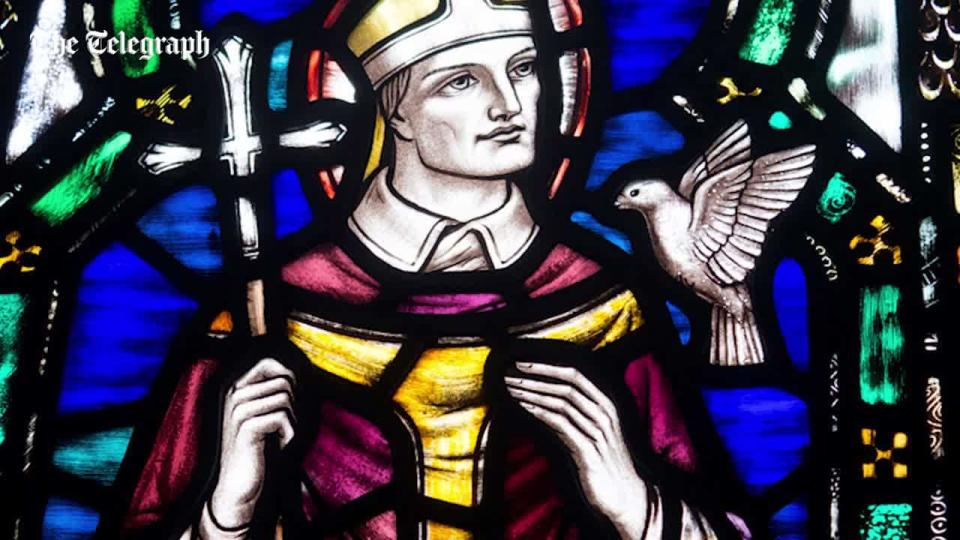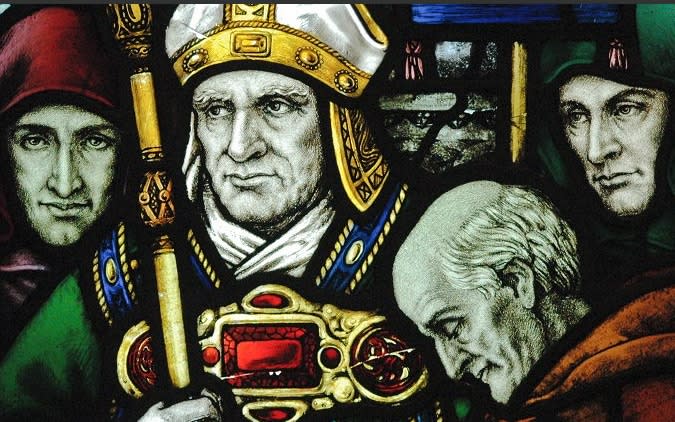St David's Day 2017: Who was the patron saint of Wales and everything else you need to know
When is St Davids Day?
St David's Day is celebrated annually on March 1st. It is the day when the people of Wales celebrate their patron saint, St David.
Who was St David? Was he Welsh?
St David is the patron saint of Wales and also of doves. Also known as Dewi Sant in Welsh, he was born in Caerfai in Pembrokshire, Wales to Sant, a prince of Cardigan, and St Non, the daughter of a chieftain in around 500 AD. He was recognised as a national patron saint at the height of Welsh resistance to the Normans.
St David studied under St Paulinus in Cardigan before he went on pilgrimages, travelling to Wales, Cornwall, Britanny, Ireland and Jerusalem, where he was made an archbishop.
He helped to spread the word of Christianity, and he founded around 12 monastaries in his lifetime. He also helped to suppress Pelegrian heresy, where people believed that original sin did not taint human nature and people are capable of choosing good or evil without divine aid.
Monastaries founded by him were known for their extreme asceticism, where monks abstained from worldly pleasures, living on a diet of bread, vegetables, water and milk. They also did all hard labour themselves, including farming without the aid of ox to plow the fields.
While little is known about St David's life, he is known for performing miracles. His most famous miracle was when he was preaching to a large crowd at the Synod of Brefi and raised the ground beneath him into a hill so his sermon could be heard by all.
St David also lived after eating bread poisoned by monks at his monastary who tired of their life of austerity, and restored the sight of his tutor, St Paulinus.
11 incredible things to do in Wales
In medieval times, St David was thought to be the nephew of King Arthur. In some stories, it is his mother who was the niece of King Arthur. Legend also says that St Patrick foresaw David's birth.
St David is thought to have died on March 1, 589 AD, and his remains were buried in St David's Cathedral in Pembrokeshire, which was a popular place of pilgrimage after he was canonised in 1120 AD.
His shrine was removed by Vikings in the 10th and 11th centuries, and a new shrine constructed in its place in the 13th Century.
Two pilgrimages to his shrine at St David's Cathedral is thought to be equivalent to a pilgrimage to the Vatican and three are equivalent to a pilgrimage to Jerusalem.
St David has been patron saint of Wales since the 12th century - he was canonised by Pope Callixtus in 1120. Of the patron saints of the British Isles, only St David and St Patrick had visited the country they are the patron saint for.
St Patrick was a Romano-British missionary, St George was a Roman soldier of Greek extraction and St Andrew was from Palestine.
Symbols and images associated with St David
The flag of St David is a yellow cross on a black background.
On St David's Day, the flag of St David and Y Ddraig Goch (the Red Dragon, Wales's national flag), will be flown more than usual.
Daffodils are raising their heads ready for #saintdavidsday#WelshWednesdaypic.twitter.com/q6agElfLhY
— Caroline Lewis (@stareawhile) February 22, 2017
Images of St David often depict him on a hill with a white dove on his shoulder. The dove represents the Holy Spirit which gifted St David with eloquent speech when he preached. Some stories say the dove is depicted because a love landed on his shoulder on the day he miraculously raised a hill to preach.
People often wear leeks in remembrance of St David's guidance during the battle against the Saxons when, supposedly, St David advised Welsh warriors to wear a leek during a battle with the Saxons, so enemies and allies could be distinguished. They won the battle and leeks became a Welsh symbol.
Famous last words
During St David's last sermon he said words to his followers were: "Be joyful, and keep your faith and your creed. Do the little things that you have seen me do and heard about. I will walk the path that our fathers have trod before us."
"Do the little things" has become a well-known inspirational saying in Wales.
Is St David's Day a public holiday?
No. While St Andrew's Day in Scotland and St Patrick's Day in Northern Ireland are public holidays, St George's Day in England and St David's Day in Wales are not.
In 2007 Tony Blair rejected calls for St David’s Day to become a bank holiday, despite a poll revealing that 87 per cent of Welsh people wanted a March 1 holiday.
School children used to be given a half-day holiday, and in some parts of Wales, this tradition continues.
St Davids Day and other British seasonal traditions in pictures
How is St David's day celebrated?
The 17th century diarist Samuel Pepys noted how Welsh celebrations in London for St David's day would spark wider counter-celebrations among their English neighbours, with life-sized effigies of Welshmen being symbolically lynched.
By the 18th century the custom had arisen of confectioners producing "Taffies" – gingerbread figures baked in the shape of a Welshman riding a goat - on St David's Day. These days, St David's Day is celebrated mainly in Wales or large populations Welsh expats living outside the UK.
People celebrate St David's day by wearing a daffodil, the national symbol of Wales, or a leek, St David's personal symbol.
In Wales people, particularly children, wear traditional Welsh costume. Girls wear a petticoat and overcoat, made of Welsh flannel, and a tall hat, worn over a frilled bonnet.
Boys wear a white shirt, a Welsh flannel waistcoat, black trousers, long wool socks and black shoes. The outfits originated during the 18th and 19th centuries.
Children in Wales enjoy traditional Welsh dances, sing Welsh folk songs and recite Welsh poems, and take part in school concerts or eisteddfodau.
Picture perfect ❤️ school photos for saint davids day ��@fcwpa#stdavidsdaypic.twitter.com/6g3urJoIhf
— Jayne Davies (@jaynedavies25) February 13, 2017
Welsh regiments in the British army traditionally eat raw leeks on March 1st to celebrate their patron saint.
Google is also celebrating the day with one of its Doodles in the search engine.
What's happening to mark the day?
St David's Day parades occur throughout the country.
In Cardiff a parade begins at 12:30pm at Cardiff City Hall and makes its way through the centre, with fiery performances from dragons. It ends at 1:45pm with the national anthem, Hen Wlad Fy Nhadau, outside St David's Hall.
There will also be show-stopping parades in Aberystwyth, Wrexham and Llandudno.
Many castles and heritage sites open their doors for the celebrations, including St David's Bishops Palace, near his final resting place.
In celebration of David, our patron saint, Caerphilly Castle will be open FREE on #StDavidsDay (Wed 1 March) pic.twitter.com/gukXmKLunz
— The Valleys (@LoveTheValleys) February 12, 2017
They speak Welsh in Argentina?
Welsh expats can be found around the world, but many have emigrated to the United States, in particular Ohio, Idaho and Pennsylvania.
Nearly 150 years ago, on July 28 1865, more than 150 Welsh-speaking men, women and children landed at what is now Puerto Madryn on the Atlantic coast of Argentine Patagonia.
They had sailed in May from Liverpool on the Mimosa, a converted tea clipper, with the intention of establishing a community where they could practise their language and faith free from the dictates of “English” government.
Patagonia, their leaders had assured them, was much like the green and fertile lowlands of Wales. In truth, it was a hard, inhospitable place where water was hard to come by and there were no trees to fell for fuel or building.
What are the lyrics to Hen Wlad Fy Nhadau, the Welsh national anthem?
Hen Wlad Fy Nhadau, translated in English as ‘Land of my Fathers’, was written in 1856 by Evan James and his son, James James, from Pontypridd.
Welsh rugby and football crowds are regularly heard singing their national anthem before international matches.
The first recorded occasion of the anthem being sung at an international sporting event was in 1905, at a rugby match between Wales and New Zealand at Cardiff Arms Park.
Here are the lyrics, in Welsh, followed by an English translation.
How to make the perfect Welsh cakes
These little icons of the Welsh table are delicious as they are, spread with butter, or served with a couple of leeks and a little cheese for a savoury teatime treat. Welsh cakes can be eaten any day of the year, but also form part of the St David's Day celebrations.
The world record for the largest Welsh cake ever made was set on St David's Day in 2014. Four chefs in Bala, Gwynedd, North Wales, baked a 1.5m wide (5ft) cake, which weighed 21.7kg (48lbs). The cake was cut into more than 200 pieces and sold for charity.
And finally...Dydd Gŵyl Dewi Hapus!
HAPPY ST DAVID'S DAY! to everyone celebrating today, throughout Wales and beyond.

 Yahoo News
Yahoo News 


